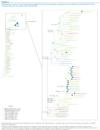

Paradigm Shift Intervention Monitoring
 twitter
twitter

Commentary
S246N Tamiflu
Resistance - Recombination & Clonal Expansion
Recombinomics
Commentary 23:15
June 10, 2011
The paper provided support for the spread of S246N via two mechanisms, recombination and clonal expansion. The phylogenetic tree below (larger version here) identifies isolates with S246N, including 2011 isolates in the expanded panel.

The top branch in the expanded panel contains isolates from the S188T sub-clade (labeled HA-S202T in the figure), the largest current sub-clade in circulation. This branch has three isolates with S246N (A/Singapore/KK64/11, A/Brunei/1/11, and A/Montana/03/11, but each isolate is on a separate branch, signaling the recent acquisition via recombination.
Recombination allows the same genetic change to jump from one branch to another, or one sub-clade to another. S246N is concentrated in another sub-clade with A/Singapore/TT89/11 at its base, with 17 additional isolates from Singapore or Australia with S246N. Thus, these additional 17 isolates, which were collected in 2011 or late 2010, all represent clonal expansion of an isolate containing S246N.
This jumping from genetic one genetic background to another, followed by the clonal expansion of a resistant sub-clade in the absence of drug treatment follows the pattern for the fixing of H274Y in seasonal H1N1 in the 2008/2009 season.
Concern for a repeat of this fixing of resistance is increased by recently released Pandemic H1N1 sequences from Italy. In most cases only the HA sequence was released, which matched the clonally expanding sub-clade in Singapore and Australia. The HA sequence for these isolates has E359A (labeled HA-E373A on tree) which is present in Italy (see list here and here).
The NA sequence from one Italian isolate was released. Although it did not have S246N, it was virtually identical to Singapore/TT89/11 rising concerns that the sequence with S246N has already expanded in Italy and Europe, or will rapidly expand in the southern hemisphere in the current season, and become fixed in the northern hemisphere in late 2011.
Media link
Recombinomics
Presentations
Recombinomics
Publications
Recombinomics
Paper
at Nature Precedings